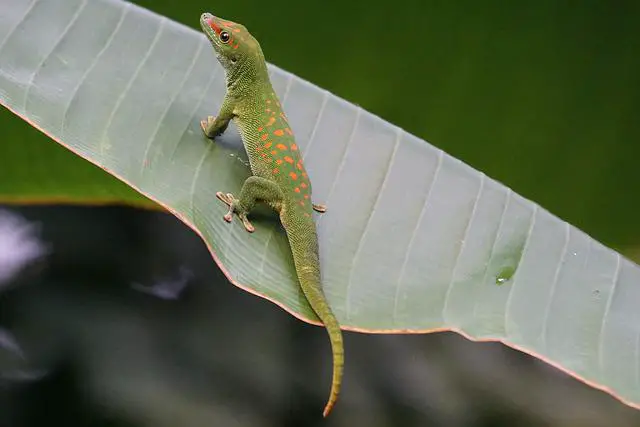Giant day geckos are fascinating, colorful creatures. This is why many people like to have them as pets.
One of the more intriguing behaviors of geckos, and reptiles in general, is shedding. You may be asking yourself, how often do giant day geckos clear?
Giant day geckos shed their skin approximately once a week when they’re young. As they get older, this frequency comes down to once a month.
Read on to find out more about why these beautiful creatures shed their skin and how to tell when a giant day gecko is about to shed. If you own a giant day gecko that’s having trouble shedding, this guide also outlines how you can help.
What Affects the Frequency of Shedding in Giant Day Geckos?
The frequency with which a giant day gecko will shed its skin varies with its life stage.
Younger giant day geckos will shed their skin every week on average. On the other hand, older giant day geckos will shed their skin every month.
This difference in shedding frequency comes from a giant day gecko’s growth rate. Naturally, the younger a giant day gecko is, the faster it grows. Giant day geckos typically stop growing after 14 months.
How to Tell When Your Giant Day Gecko Is About to Shed
If you own a giant day gecko, you’ll easily be able to tell when it’s getting close to removing its current layer of skin and making way for a new one.
The first sign to look out for is the color of your gecko’s skin. If you notice that it’s become duller and more translucent than usual, your gecko is likely approaching its shedding time.
Another thing to keep an eye on is changes in your giant day gecko’s behavior.
When geckos are getting close to shedding, you’re likely to see them biting at their skin and strangely moving their legs. You’ll also notice that they have difficulty sticking to things inside their enclosure.
Some geckos will also lose their appetite when shedding, so watch out for that too.
Why Do Geckos Shed?
As with all reptiles, giant day geckos’ skin doesn’t grow with their bodies. Therefore, the current outermost layer of skin stretches out as they grow.
However, there’s a limit to that skin’s ability to expand. This is because the skin is thick and is designed to act as a gecko’s first line of defense against potential threats.
When the skin has reached that limit, giant day geckos need to get rid of it and clear the way for the newer layer of skin beneath it.
Why Do Geckos Eat Their Shed Skin?
If you see your giant day gecko gobbling up its shed skin, don’t be alarmed; this is normal behavior.
Eating their shed is an instinctive behavior for geckos that has multiple justifications.
First, a gecko’s shed skin is packed with nutrients and minerals. Geckos don’t let that good stuff go to waste; they eat their shed to take advantage of them when growing new skin.
They also do so to compensate for the nutrients they’ve lost during shedding, which is a task that consumes a lot of energy.
Another reason geckos eat their shed is that it allows them to remove any trace of their presence in a particular area when in the wild. This helps keep them safe from any predators lurking around.
The final reason for this behavior revolves around hygiene. Geckos like to clean their living area, which is why they eat their shed instead of leaving it lying around.
How to Help Your Giant Day Gecko Shed
Usually, giant day geckos can shed their skin without any need for outside help. However, they sometimes experience some issues when shedding.
Here are some things you can do to make your giant day gecko’s shedding a smoother experience.
Create the Right Conditions
Giant day geckos are native to tropical habitats; their idea of optimal conditions includes a relatively high humidity level.
Failing to provide your giant day gecko with this humid environment can cause its skin to dry, making it more challenging to shed.
Therefore, you should see misty your gecko’s enclosure with sufficient frequency.
.
Peel Away the Skin Yourself
If your gecko has trouble shedding, you can try to facilitate the process using your hands and a damp cloth.
Rub the problematic area gently with the cloth; this will help make the skin easier to remove. Next, you should try to peel the skin away very gently.
Note: Only try this when trying to peel the skin off a low-risk area, such as your gecko’s back. It’s strongly advised to avoid this method if the skin your gecko is having difficulty shedding is in a sensitive area such as its eyes or tail tip.
Soak Your Gecko in Warm Water
Another way to make your giant day gecko’s life easier when shedding is to put it in a shallow bowl of warm water for 20-30 minutes.
This will help eliminate the dryness in your gecko’s skin that’s causing it to be challenging to shed.
Conclusion
So, how often do giant day geckos shed their skin?
The answer to that question depends on how old a giant day gecko is.
A giant day gecko still in its infant stages of development proliferates. In turn, it sheds its skin almost every week. Giant day geckos in more mature stages of growth will typically shed their skin every month.
Shedding is usually a routine task for geckos that goes relatively smoothly. However, a gecko can sometimes be challenging to shed if exposed to dry conditions.
To avoid this, keep your giant day gecko’s enclosure at an adequate humidity level.




